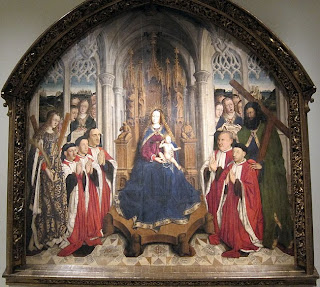WHAT MUNZER COULD HAVE SEEN IN BARCELONA AND WHAT HE NEVER SAW
What Münzer Could Have seen in Barcelona
There are many more physical remains in Barcelona from the 15th century. We are not quoting Münzer’s historical accounts—they tend to be “fuzzy history” at best, as Ramon Alba pointed out in his 2000 translation of Münzer into Spanish. But Münzer was right in noting a steep decline in the city by the time he got there from its 13th-14th-century zenith. Most of the earlier infrastructure was maintained in the 15th century, so the metropolis was still impressive. What has survived is a patchwork: the former monastery churches of Santa Anna, Sant Pere de les Puelles, Sant Pau del Camp, and Santa Maria dels Jonquers, as well as part of the cloister of Sant Augustí Vell (found within a pastry-making academy). All have gone through periods of neglect, partial destruction, various restorations and in the case of Santa Maria dels Jonquers, a stone- by-stone moving to the Rambla de Catalunya near the Diagonal. Various palaces also survive as well as parts of other stone civic buildings and residences, and retablos, sculpture and church decorations as well as some domestic objects are divided between several museums (most prominently the Museu Nacional d’Art de Catalunya).
Once again, Münzer does not mention a single work of art except for the monstrance, though there are plenty of works of art that Art Historians consider important, such as Lluís Dalmau’s “Virgin of the Counselors around. One prominent citizen of the city was the Canon LLuís Desplà i Oms, Archdeacon and also president of Barelona’s Generalitat, whose sumptuous palace was being constructed facing the unfinished Cathedral façade, and incorporating parts of the old Roman walls. Though amalgamated with another palace, it’s still there and now houses the city archives. Desplà was an eager humanist, and would have certainly had a lot to discuss with a visiting intellectual like Münzer. Art historically, he is now chiefly remembered as having painted the “Pietà” by Bartolomé, now in the Cathedral museum, but originally in his private chapel.
What Münzer Never Would Have seen in Barcelona:
Take a look at a Google satellite map of Barcelona, and you can see the convoluted core of the medieval city, and the mitered grid beyond it of the post 1850’s city plan called the Eixemple, and later expansions beyond that. The city now fills all of Münzer’s “beautiful plain.” Though not from the highest tower in the city, the view from Montjüic below offers some idea of the city’s ever-growing extent. As Münzer would say, “for the sake of brevity I omit details,” but there are plenty of wonderful guidebooks that do a nice job of cataloging this urban growth.
After a long decline, Barcelona became very wealthy in the later 19th century, when the Eixemple was planned and built up. The Catalan language was also revived at this time. The end of the Spanish Civil war in 1939 ground everything to a screeching halt (Catalan was banned too), and the third revival began after Francisco Franco’s death I the 1970’s. Now the city is booming again, and there’s active restoration of many more sites, and a lot of creative reuse of old spaces. One of my favorites is the recycling of one of Barcelona’s two bull rings (Plaza de Toros las Arenas--in use 1900-1977) into a 3-story shopping mall.






No comments:
Post a Comment